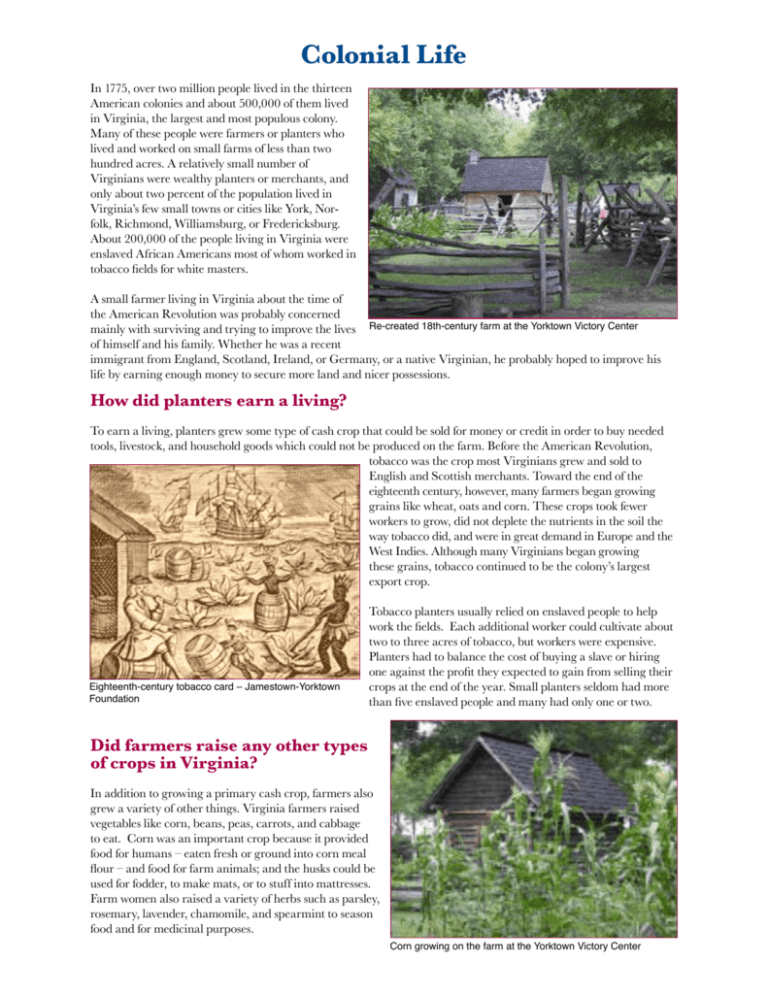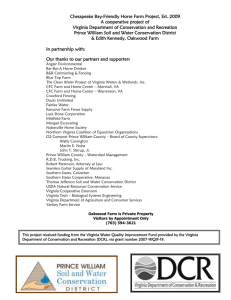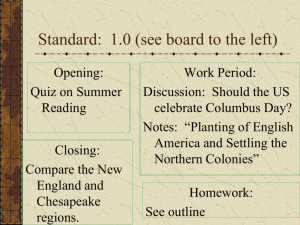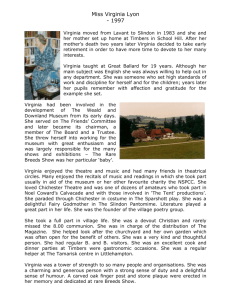Colonial Life - Jamestown Settlement and Yorktown Victory Center
advertisement

Colonial Life In 1775, over two million people lived in the thirteen American colonies and about 500,000 of them lived in Virginia, the largest and most populous colony. Many of these people were farmers or planters who lived and worked on small farms of less than two hundred acres. A relatively small number of Virginians were wealthy planters or merchants, and only about two percent of the population lived in Virginia’s few small towns or cities like York, Norfolk, Richmond, Williamsburg, or Fredericksburg. About 200,000 of the people living in Virginia were enslaved African Americans most of whom worked in tobacco fields for white masters. A small farmer living in Virginia about the time of the American Revolution was probably concerned mainly with surviving and trying to improve the lives Re-created 18th-century farm at the Yorktown Victory Center of himself and his family. Whether he was a recent immigrant from England, Scotland, Ireland, or Germany, or a native Virginian, he probably hoped to improve his life by earning enough money to secure more land and nicer possessions. How did planters earn a living? To earn a living, planters grew some type of cash crop that could be sold for money or credit in order to buy needed tools, livestock, and household goods which could not be produced on the farm. Before the American Revolution, tobacco was the crop most Virginians grew and sold to English and Scottish merchants. Toward the end of the eighteenth century, however, many farmers began growing grains like wheat, oats and corn. These crops took fewer workers to grow, did not deplete the nutrients in the soil the way tobacco did, and were in great demand in Europe and the West Indies. Although many Virginians began growing these grains, tobacco continued to be the colony’s largest export crop. Eighteenth-century tobacco card – Jamestown-Yorktown Foundation Tobacco planters usually relied on enslaved people to help work the fields. Each additional worker could cultivate about two to three acres of tobacco, but workers were expensive. Planters had to balance the cost of buying a slave or hiring one against the profit they expected to gain from selling their crops at the end of the year. Small planters seldom had more than five enslaved people and many had only one or two. Did farmers raise any other types of crops in Virginia? In addition to growing a primary cash crop, farmers also grew a variety of other things. Virginia farmers raised vegetables like corn, beans, peas, carrots, and cabbage to eat. Corn was an important crop because it provided food for humans – eaten fresh or ground into corn meal flour – and food for farm animals; and the husks could be used for fodder, to make mats, or to stuff into mattresses. Farm women also raised a variety of herbs such as parsley, rosemary, lavender, chamomile, and spearmint to season food and for medicinal purposes. Corn growing on the farm at the Yorktown Victory Center What kinds of animals were found on farms in Virginia? Animals served many uses on Virginia farms. Oxen and horses were strong work animals that could be used to pull carts and wagons, plow the fields, and carry tobacco from the farm to the tobacco inspection warehouse. Farmers also raised pigs, cows, chickens and other fowl for food. Pigs were slaughtered for meat, lard, or soap for the farm. Sheep were raised for wool which could be spun into yarn and then knitted or woven into cloth. Beef was a popular food on Virginia farms, and cows produced milk for both butter and cheese. Chickens, geese, guinea fowl, and turkeys provided eggs, meat, and feathers. Deer, wild fowl, and other game were hunted to supplement the family diet. Feeding a turkey on the farm at the Yorktown Victory Center In what kinds of homes did average Virginians live? Unlike the wealthy planters who lived in great houses on large plantations, the average Virginian had a small house, with one or two other wooden buildings on his plot of land. A typical farm family, consisting of a mother and father and four to six children, lived in a one or two-room wooden house that was often no larger than 16 by 20 feet, or about the size of a garage today. These houses usually had a chimney and fireplace with space for storage or sleeping in an upstairs loft. Some had wooden floors, but many simply had dirt floors. Typical wooden Virginia plantation house – Jamestown-Yorktown If the farmer had carpentry skills, he might have built Foundation his home himself, but if not, he could hire a carpenter to do the work for him, often in exchange for farm products or return labor. The kitchen, tobacco barn, and storage buildings were usually separate from the main house. If the farmer owned slaves, they may have lived in one of these outbuildings or in a cabin nearby. What was a man’s role on a farm? The planter’s main job was to raise the cash crop and manage the slaves, but those who lived on small farms performed many other jobs as well. Depending on their skills, men built and repaired buildings, fences, and simple furniture for the household. Hunting, to feed the family and to keep pests away from crops and livestock, and fishing were other important tasks undertaken by most farmers. Items not produced on the farm were purchased from local merchants or imported from England. Sometimes the planter paid cash for these goods, but he usually bought on credit and paid off his account when he sold his next crop of tobacco or wheat. Tobacco drying in tobacco barn at the Yorktown Victory Center Virginia planters who were land owners had civic duties as well, such as paying taxes, voting, and participating in county courts as jurors. Men between the ages of 16 and 60 were also required to serve in the county militia. They were required to muster several times each year and had to provide their own gun and ammunition. Militia units were used to keep the peace, fight Indians and put down slave rebellions, if necessary. Muster days also served as good opportunities for men to gather with their friends and neighbors. Work on the small farm or plantation was determined by the season, and certain jobs were performed at the same time each year. For tobacco planters, seeds were planted in beds in January, fields prepared in the early spring and seedlings transplanted around May. The summer was spent worming, weeding, watering, and topping the tobacco plants to ensure good quality tobacco would be harvested by September. During the fall, the tobacco was hung in tobacco barns and cured or dried, then packed or prized into wooden barrel-shaped containers called hogsheads to be taken to the inspection warehouse down by the river. The process of growing and selling tobacco took a great deal of time and lasted until the following year when the hogsheads were loaded onto ships and sent to England for sale. Growing grains like wheat, corn, and oats took less time, and the growing season was much shorter. Wheat and oats required little attention between planting in early spring and harvesting in June and July. The slack times throughout the year were good times to repair tools, fences and buildings, cut timber, shuck and grind corn, manure the fields, and ship the last season’s grain to market. What was a woman’s life like on a farm? Carpentry work on the farm at the Yorktown Victory Center The busy life of women on Virginia farms fit into the seasonal cycles and the growing season of the cash crop as well. In the winter and spring, spinning and sewing were done. In the late summer and fall, women dried and stored fruits and vegetables for winter meals. Hogs were butchered in the fall and the meat made into sausage or salted and smoked for preservation. Tallow candles and lye soap were made with leftover animal fat. Planter’s wives often grew herbs such as spearmint, peppermint, lavender, rosemary and parsley which were used to season foods and make home healthcare remedies. Other common crops on Virginia farms were cotton and flax. Though most families bought imported fabric when they could, the long, tough fibers inside the flax plant could be spun on a spinning wheel to make linen thread. This thread was later woven into linen cloth for clothing and bedding. Throughout the year, women cooked, knitted, and sewed clothing, tended the slaves and livestock, and raised the children. On some small farms, women worked in the fields helping to grow crops, but most women spent their time running the household. Women spinning on the farm at the Yorktown Victory Center What was the role of children on a farm? Children’s chores and education varied, depending on whether they were boys or girls. Very young children were under their mother’s care. Public schools were not available in colonial Virginia, so children often learned everything they needed to know at home. Some boys received limited schooling from their local Anglican minister. Formal education was usually only considered for boys because they were expected to learn how to run the farm, make purchases, deal with finances, and manage slaves. If his parents were literate, a young boy might be taught reading, writing and arithmetic at home. Most young girls learned to cook, spin, and sew from their mothers, and they might have learned to write their names and read the Bible. Some children used a hornbook to learn their letters. A hornbook was a primer with the letters of the alphabet, mounted on wood, bone, or leather and often protected by a thin sheet of Hearth cooking in the farm kitchen at transparent horn. Few Virginians could afford the Yorktown Victory Center to own many books; many owned only a Bible. Children’s books, which were available to the wealthy, often had a moral lesson. Aesop’s Fables were among the most popular children’s stories. Some older boys (and a few girls) worked for a master tradesman as apprentices. While serving their five to seven-year apprenticeship, they not only helped their master do important work, but also learned the skills of the trade and received an education as well. Eighteenth-century hornboook – Jamestown-Yorktown Foundation What was life like for enslaved people on Virginia farms? A slave is a person who is owned or enslaved by another person. In colonial times, people from the west coast of Africa were captured and shipped to Virginia and other colonies to work as slaves. In Virginia these Africans lived and worked on plantations or small farms where tobacco was the cash crop. Enslaved for life, they could be bought or sold as property. Enslaved people in Virginia faced a life of great hardship. Those on smaller farms often lived in a kitchen or other outbuilding or in crude cabins near the farmer’s house. On large tobacco plantations, the field slaves usually lived in cabins grouped together in the slave quarter, which was farther away from the master’s house but under the watchful eye of an overseer. Although large plantations had many enslaved people, most owners usually had fewer than five, including children. Living on a small farm often made it hard for black Work in the farm kitchen at the Yorktown men and women to find wives and husbands to start families. Sometimes white Victory Center masters split up families and sent parents or children to different places to live and work which also made it difficult to raise a family. As a general rule, enslaved people worked from sunrise to sunset, usually in the tobacco fields. On large plantations, some learned trades and worked as blacksmiths, carpenters, and coopers or served as cooks and house servants. At the end of the workday and on Sundays and Christmas, most enslaved people had a few hours to tend to personal needs. They often spent this time doing their own household chores or working in their own gardens. Many masters allowed their slaves to raise chickens, vegetables and tobacco during their spare time, and sometimes they were allowed to sell these things to earn a small amount of money. When they could, slaves spent their evenings and limited free time visiting friends or family who might live nearby, telling stories, singing, and dancing. Many of these activities combined familiar African traditions with British customs learned in the New World. Some of the slaves’ dances were similar to their African tribal dances, and their songs often told stories about how their masters treated them and the injustices of slavery. Some musical instruments used by enslaved people were similar to those used in Africa. The banjo, made out of a hollow gourd, and the drum were two instruments that slaves made and used to create music. In Virginia, teaching enslaved people to read and write was generally not encouraged. Some learned secretly, but for those living on small farms where the master’s family was not well educated, there was little opportunity. Black Virginians kept some parts of their African religions as well. The life of a slave was hard and often cruel, and their religion was an important way to remind them that their lives had meaning and dignity. Eighteenth-century tobacco card – JamestownYorktown Foundation Many found ways to resist the hardships of slavery. Prolonging their work, breaking or hiding tools or pretending to be sick, were safe and effective ways to resist the authority of their masters. Some enslaved people ran away to find family in other parts of the country or attempted to escape to the wilderness to begin a new life. Ads printed in the Virginia Gazette describe these runaways, and they were often captured and returned to their masters. Those who could not escape might attempt to destroy their master’s crops or other property or steal food to feed their families. Such actions were usually met with harsh punishment or death. Life of enslaved persons on an 18th-century Virginia farm How did slavery develop in America? In 1501, shortly after Christopher Columbus discovered America, Spain and Portugal began shipping African slaves to South America to work on their plantations. In the 1600s, English colonists in Virginia began buying Africans to help grow tobacco. The first Africans who arrived at Jamestown in 1619 were probably treated as servants, freed after working for a set number of years. By the early 1700s, the Virginia Assembly had passed a set of Black Codes, or slave laws, which institutionalized life-long slavery and stipulated that offspring of a female inherited their enslaved status from their mother. How did people in Africa become enslaved in Virginia? Eighteenth-century tobacco card – JamestownYorktown Foundation Africans who arrived as slaves had already suffered many terrible months before reaching Virginia. Most lived in tribal villages in western Africa before they were captured in wars or kidnapped by other Africans who traded slaves. The captives were tied together in long human chains called coffles and forced to walk many miles to a trading fort on the sea coast. They were then sold to white slave merchants who packed them into large slave ships that carried them across the ocean to America. The voyage across the Atlantic Ocean was called the middle passage and was one of the most frightening experiences that many enslaved people ever endured. During a four to six week voyage in the cramped hold of the slave ship, as many as one out of five slaves died as a result of mistreatment, filthy conditions and inadequate food and water supplies. Those who survived the middle passage arrived in Virginia tired, weak, sick, and probably terrified. The slaves’ nightmare did not end when the middle passage was over. Once they arrived at a port in Virginia, such as the one at Yorktown, slaves were brought up on the deck of the ship and sold. Tobacco planters poked and prodded each slave to see if he or she was healthy and strong enough to do the hard work in the tobacco fields. Most enslaved people had been separated from their families when captured or when sold at the slave market. Once they were sold, both men and women were put right to work Preparing to leave African shores - photo from 1607: hoeing in the tobacco fields, usually during the hot Virginia A Nation Takes Root summer. During their first year in Virginia, new slaves went through “seasoning” which meant letting their bodies get used to the new climate and the many new diseases found in Virginia. Many enslaved people died within the first year. Were all blacks in Virginia enslaved? Not all black Virginians were enslaved. From Virginia’s early history, a few black people were free. By 1782, there may have been as many as 2,000 free black people living and working in Virginia. Free blacks often worked as farmers and as tradesmen, and some owned property including slaves of their own. What was the role of religion in Colonial Virginia? Working in the vegetable garden on re-created farm at the Yorktown Victory Center Prior to the Revolution, the Anglican Church was the “established” religion in Virginia. Since 1624, white Virginians were required by law to attend and support the Church of England. Though there were dissenting Protestant denominations by 1775, like the Baptists, Methodists and Presbyterians, the established church was supported by taxes. At this time, there were very few Catholics or Jews in the colony. A small farm family would most likely have worshipped in the local Anglican Church. Sunday services would provide a social outlet for the farm family as well. What choices faced an average Virginia farm family due to the war? Farm families worked hard to keep themselves alive and healthy and to try to improve their lives from year to year. Many white families in Virginia actually did improve their lives by a modest amount during the years before the American Revolution. Although very few Virginia families became a great deal wealthier, these modest gains made many farmers content with their lifestyle. As the thirteen colonies began to move towards war with England, many small planters faced difficult decisions. Some would support the patriots’ cause; some, called loyalists, would remain loyal to the King. Others remained neutral, seeing as their only choice to continue the hard work required to make their farms successful and hope that the outcome of the war would not take away the things they had earned. How did the American Revolution affect the lives of blacks in Virginia? When the American Revolution began, black Virginians were faced with difficult choices as well as opportunities. The patriots’ talk of freedom and liberty excited many black people with the chance of ending their slavery. Many enslaved people enlisted to fight on both sides of the Revolutionary War with the hopes of gaining their freedom. Virginia’s Royal Governor, Lord Dunmore, offered freedom to any enslaved person owned by a patriot who would run away to fight with the British Army. Nobody knows exactly how many hundreds of enslaved Virginia men and women escaped to join the British during the war, but most of them never secured permanent freedom. Many died of smallpox; others were returned to their masters or were left behind when the British left. Many fewer blacks fought on the American side than for England. At the beginning of the war, the Continental Army, and most of the thirteen states, would not Musket firing at the Yorktown Victory Center let black men serve in their units. By the end of the eight-year war though, many blacks were finally allowed to join and fight for the patriotic cause. Other blacks served as drummers, fifers, cooks, wagon drivers, and river pilots. Many hoped that their service would lead to freedom from slavery. By the time the American Revolution ended, enslaved people all over Virginia had come to realize that the patriots’ talk of liberty and freedom only meant liberty and freedom for white men. A few who fought for the British ended up in colonies of freed men in Nova Scotia and Sierra Leone. Some who fought on the American side, primarily those from the northern colonies, were rewarded with their freedom. For most black Virginians, however, the hard life of slavery continued just as before the American Revolution. African Americans found out that Thomas Jefferson’s famous statement in the Declaration of Independence that “all men are created equal” did not include black men. It was not until after the American Civil War that all black Virginians gained the freedom promised by the American Revolution. Re-created Continental Army encampment at the Yorktown Victory Center © Jamestown-Yorktown Foundation P.O. Box 1607, Williamsburg, VA 23187





